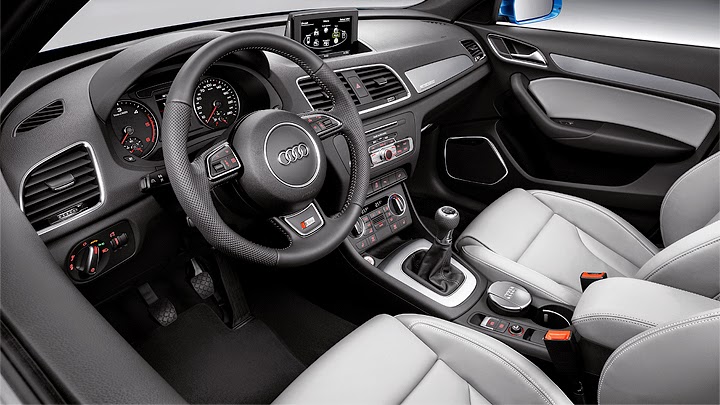
Q3’s very first facelift comes in a very important moment for its market. Mercedes-Benz extended A-Class’s great acceptance to this category with GLA, while Lexus debuted in it with NX as part of its growth plan. BMW, in turn, decided to work in a different way: X1 started to be produced in Brazil, in order to improve its image among Latin-American customers. The response, as the pictures anticipate, came in Audi’s typical style: big technical evolution, little visual evolution. The new crossover brings essentially an improvement of its predecessor, which means Audi should expect at least the same sale standards it reaches today. Those who probably won’t like anything about this are North-Americans: the old Q3 arrived there only a year ago.
From every angle you look there is something new, but not all of them will make those easy to spot. The front fascia attempts to resemble the Crosslane concept’s front grille, giving the signature hexagon a three-dimensional profile. The more horizontal design makes Q3 look wider and lower than it really is, which aids to a sporty feeling, but it’s impossible to look at those chrome connections between grille and lights without remembering of the latest BMWs. The rear features refreshed lights and bumper. The sides, in turn, received new wheels (from 16” to 20”) and full body-color paint finish (the lower portion used to come always in black). The intention, once again, was to refresh the original look without expressive investments.










Entering the car shows fewer novelties. The seats were retouched, the steering wheel is new, and the equipment list was increased with more electronic safety systems, such as blind-spot warning, lane-keeping assist, and traffic-sign reminders. Besides, Audi Drive Select is now offered as standard, which means every Q3 owner will be able to set the car’s behavior according to its will. The headlights became equipped with Audi’s very latest LED technologies, specially on upscale trim levels. This means you’ll get some interesting features like turning signs that swipe across the lamp, because it’s claimed to attract more attention than the old-fashioned lamp blinking. This facelift is already offered for all trim levels, including the super-sporty RS Q3.
As far as performance is concerned, the engine list welcomes the new TFSI 1.4L, which already appears in A1 and A3. Always equipped with front-wheel-drive here, it reaches 148 hp and uses manual or S-Tronic transmissions. If you’re interested in saving fuel, this engine can deactivate two of its four cylinders whenever they’re not needed, in order to reach a combined 21.4 kpl. Another renewed option is the TFSI 2.0L, which is now good for 178 hp and always comes with all-wheel-drive. RS Q3, in turn, had its five-cylinder 2.5L boosted to 335 hp and 332 lb-ft, besides becoming Euro 6 compliant. Its transmission features two clutches, seven speeds and faster changes, which collaborate to a 0-100 kph time as impressive as 4.8 seconds.
Lançamento no Brasil (02/06/2015)
Ao mesmo tempo que ostenta linhas renovadas, o Q3 aproveita os holofotes para apresentar toda uma linha nova de versões no Brasil. Para ficar mais competitivo, ele usa o motor 1.4 TFSI de 150 cv na Attraction (R$ 127.190) e na Ambiente (R$ 144.190). Estas podem ganhar o motor 2.0 TFSI de 180 cv e passar a R$ 145.190 e R$ 165.190, na ordem. Este último é a única opção da Ambition (R$ 190.190), mas gerando 220 cv. As três últimas usam a tração integral quattro. Com o primeiro motor, o crossover acelera de 0 a 100 km/h em 8,9 segundos e chega à velocidade máxima de 204 km/h. Estes números passam a 7,6 segundos e 217 km/h no segundo, e a 6,4 segundos e 233 km/h no terceiro, sempre de acordo com os dados oficiais da Audi.
Entre os equipamentos disponíveis desde a versão básica, vêm ar-condicionado, bancos em couro, computador de bordo, rodas de 17”, sensores de chuva e crepuscular, Audi Drive Select para modos de direção, volante esportivo com borboletas. Quanto à segurança, estão lá airbags frontais, laterais e de cabeça, controle de estabilidade, farois de xenônio, freio de estacionamento eletromecânico, sensor de estacionamento traseiro, hill holder, e lanternas em LEDs. O porta-malas leva 460 litros, mas pode ser levado a 1.365 litros com os bancos traseiros rebaixados. Este modelo já se encontra à venda no país, e é um dos que a Audi pretende produzir no Brasil a partir do ano que vem. Ele sairá da fábrica de São José dos Pinhais (SP) junto com o A3 Sedan.